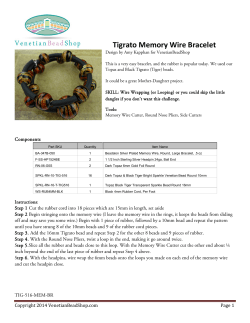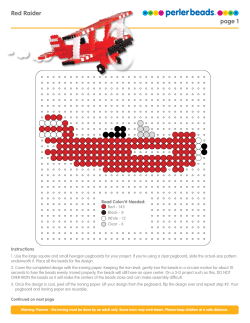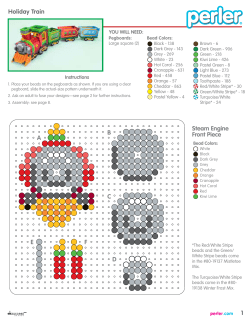
DNA Keychains Teacher Information
DNA Keychains Teacher Information Overview: For this activity, students use beads and wire to create a DNA molecule that shows the sugar/phosphate backbone as well as the paired nitrogen bases. After they are done with the keychains, we use them to see what happens during DNA replication. Visit http://accessexcellence.org/AE/AEC/AEF/1995/ross_jewelry.html to view the original activity description. I have changed the instructions to make it easier for my junior high students to construct their keychains with the least amount of challenges. Materials Needed: • 6 mm faceted beads - 52 beads per student (26 of two different colors) • Seed beads (Size 6/0 or 8/0) - 24 beads per student (6 of 4 different colors) • 20 gauge wire- 18” per student (May use 20 gauge floral wire already cut to 18” pieces) • 26 gauge wire - 20” per student • Lanyard hooks or key rings - 1 per student • You will also need needle-nose pliers & wire cutters (1 for each group), plastic containers for the beads (small and large), small plastic cups for holding beads, copies of the DNA Keychain Guide for each group Notes: (1) You will want to make a few key chains on your own before attempting this with a class. I have created a PowerPoint presentation that outlines the steps and includes the diagrams from the keychain guide. It is available on website along with color copies of the guide and related activity pages - see the link below. (2) I purchase most of my materials through online craft stores, such as Crafts Etc or ConsumerCrafts.com. Walmart or local craft stores are also good sources for wire and key chains. To offset the costs, you might consider having the students pay 50¢ each. I let my students make one keychain for free for their class assignment and then allow them to purchase materials for 50¢ to make others for their friends and family members. Usually the amount of money I raise covers a large percentage of the cost of the materials. (3) I have six groups of tables in my classroom, so I set up six sets of materials in rectangular plastic tubs. Each set contains one container of large beads, a smaller container of seed beads, several pieces of thick wire, a roll of thin wire, 1 pair of pliers/wire cutters, and 8 small plastic cups to keep beads in one place. At the end of each class, I am able to do a quick check of the materials and can easily see what needs restocked or if there are missing items that need to be found! (4) Challenging parts ... • My students have the most difficulty learning how to do the “cross two in the middle.” I used two large metal rings to show them the correct way to do the step. I placed both rings on one hand and “threaded” other hand through the rings in the other direction. Tell the students that the step is similar to tying a shoe - cross the wires and pull to form a knot. • Some of the students did not keep the thin wire tight while they were building the model and ended up with key chains that did not look the greatest. Remind the students to keep the thin wire tight after each step - cross two in the middle or thread two on the sides. • Many students decided to alternate the base pairs - A with T on one rung followed by G with C on the next - to make it easier. Students may choose to do all the A/T pairs before adding the G/C pairs or mix it up any way they would like as long as the correct bases are paired each time. Go to http://sciencespot.net/Pages/classbio.html#DNAKeychains to find all the materials for this activity. Developed for use with the DNA Jewelry activity at http://accessexcellence.org/AE/AEC/AEF/1995/ross_jewelry.html Related activities: DNA Keychain PowerPoint – I have developed a PowerPoint presentation that guides students through the steps in making a DNA keychain. The presentation includes the diagrams on the DNA Keychain Guide (next page) as well as the answer key for the DNA Replication activity listed below and links to two online activities. It is available at http://sciencespot.net/Pages/classbio.html#DNAKeychains. DNA Replication - Students color a paper model of their DNA molecule and "replicate" it. The worksheet also includes related questions on protein synthesis. The PowerPoint for this activity includes the DNA Keychain Guide as well as the answer key for the replication worksheet. It also includes links to online activities related to replication and protein synthesis. Students color the paper model to represent the order of the bases in their DNA molecule. The paper strips are cut apart and used for the replication activity. Mystery DNA - Before we cut apart the paper models, I challenge students to use a paper model to help them find the matching DNA molecule. I try to make sure that the student doesn't get his/her own copy to make it more challenging. One the match is found (and proven by showing the order of the bases), the keychains and paper models are returned to their owners. DNA Keychain Guide Get Your Materials 1. Choose your large beads for the sugar and phosphate molecules that make up the backbone. You will need 26 beads of 2 different colors for a total of 52 beads. Color the key provided. 2. Choose your small beads for the nitrogen bases. You will need 6 beads of 4 different colors for a total of 24 beads.. Color the key provided. 3. Get a piece of THICK wire from your teacher and bend it in half. 4. Cut a piece of THIN wire – 20 inches in length - and bend it in half. Build Your DNA Molecule 5. Add two SUGAR beads– one on each side – to the THICK wire. 6. Next add two PHOSPHATE beads of the other color – one on each side of the wire. 7. Place one A bead and one T bead in the middle of the THIN wire and hold it in place at the top of the phosphate beads. Line up the THICK and THIN wires on each side and hold at the top. top 8. Slide one SUGAR bead down one end of the thin wire and thread the thick wire through as you push it towards the bottom of the keychain hain - both wires are need to be threaded "inside" the large bead . Add another SUGAR bead on the other side in the same way. Thread both wires through the large beads on the side! 9. Slide one PHOSPHATE bead down one end of the thin wire and thread the thick wire through as you push it towards the bottom of the key keychain - both wires are need to be threaded "inside" the large bead . Add another PHOSPHATE bead on the other side in the same way. 10.. Pull the large beads down towards the bottom of the keychain and pull on the ends of the thin wire to make the small beads fit tightly in place. 11. Hold one of the thin wires near the end and add a G bead and a C bead. Thread the end of the other thin wire back through the G and C beads in the opposite direction make the wires form an X shape. Pull the ends as if you were “tying” a knot. Thread the other end of the wire through the beads in the opposite direction. Pull on both ends of the thin wire to “tie” it together 12. Add more big beads (SUGARS & PHOSPHATES PHOSPHATES) to the backbone – TWO on each side. Thread the THIN wire through the large beads as you add them to the THICK wire. 13. Continue building the DNA molecule following the same process – you’ll ll need 26 large beads on each side and 12 pairs of bases in the middle. Developed for use with the DNA Jewelry activity at http://accessexcellence.org/AE/AEC/AEF/1995/ross_jewelry.html Finish Your DNA Molecule 14. Once you have added all the base pairs, twist the ends of the thin wire together tightly and add dd a key ring to the other end of the keychain. 15. Use pliers to twist the ends of the thick wire and the thin wires together all at once. 16. Use the wire cutters/pliers to cut off the ends leaving it about ½ inch long. Use the wire cutters/pliers cutters/ to bend and “tuck”” the ends in between the large beads so it won’t poke you. 17. Twist your DNA strand around a pencil or finger and gently pull on the ends to create the double helix shape. CAUTION: Untwisting and twisting your keychain too many times will make it break! When you are done, color the BASES on a paper model of your DNA keychain. Be sure the colors of the bases match exactly! Writee your name on the back of the paper model. Turn in your keychain and the paper model to your teacher.
© Copyright 2025
















